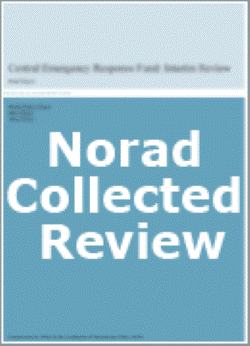A Discussion Paper on Donor Best Practices Towards NGOs in Nepal
Om publikasjonen
- Utgitt: mars 2007
- Serie: Norad-innsamlede rapporter
- Type: --
- Utført av: Amina Singh, ODC/IDMS, Nora Ingdal, NCG
- Bestilt av: The Working Group, Donor Heads of Agencies, including the Royal Norwegian Embassy, Nepal
- Land: Nepal
- Tema: Sivilt samfunn
- Antall sider: 41
- Serienummer: 10/2007
- ISBN: 978-82-7548-228-8
- ISSN: --

The civil society movement is a relatively new phenomenon in Nepal, developing explosively from 249 in 1990 to 19 944 registered NGOs by July 2006, with estimations as high as 30 000.
The Working Group of Donor Heads of Agencies, where the Norwegian Embassy is represented, commissioned this study in early 2007 to guide their discussions, provide views from the NGOs themselves, point at areas of consensus and give recommendations for the future on NGO/donor relationships. The study does not give a detailed overview of the contributions from the various donors, but refers in general and points at examples when discussing the various issues treated. Norway is reported as one of the minor contributors among the donors to the NGO sector in Nepal.
Interesting Findings
• There was a noticeable difference in the level of engagement with the NGOs among the different donors. While DFID, SDC (Swiss Agency for Development and Cooperation) and Danida has a direct and "hands-on" approach to their partners' management and governance practices, Norway and USAID hardly channel any direct support to civil society(a few exceptions), rather through INGOs (International NGOs).
• The closer the agency is to the community and Nepali NGOs vis-à-vis these arrangements, the greater the relevance of donor behaviour and how it is perceived by the civil society, implying higher degree of mutual expectations.
• The establishment of the Basic Operating Guidelines (BOGs) were seen by members of the INGOs and NGOs as a "best practice" example of donor coordination.
• The current main crux of the matter in Nepal is how to reach out to the most excluded and needy. Some INGOs do this by bypassing intermediary Nepali NGOs, at the same time running the risk of weakening this level.
• There was consensus on important issues (see next point), but disagreements on issues related to the role of independent boards and the dual role of management and board members, and also no agreement for how to deal with NGOs "internal fund" nor overhead costs.
• Points of consensus between donors - NGOs:
- There is a clear right and authority of donors to conduct strict financial monitoring in adherence with the country's laws
- Donors need to harmonise further in their financial monitoring standards and procedures
- Social inclusion and diversity are highly relevant principles for partnership guidelines
- Contribution to project costs by community/NGOs should be encouraged
- Use of public audits as effective tool for promoting ownership, accountability and transparency of programmes.
